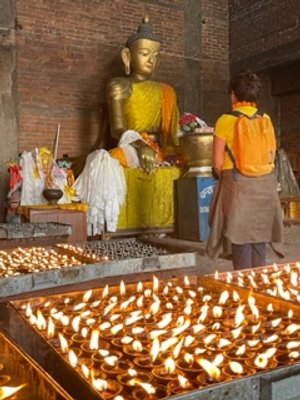Everyday Buddhism … In Another World
25 years ago, I did a high-altitude Himalayan trek and the lead guide, Gombu Sherpa, has become a close family friend since. Years ago, Gombu immigrated to the United States and still returns to Nepal twice a year to visit family, friends and lead trips. Gombu invited me and my wife Judy (ordained as both a Shin Buddhist MA and Plum Village Zen Buddhist O.I.) to join him in this spring Nepal. We wanted to see Nepal through the lens of a Buddhist Pilgrimage as well as a traditional Himalayan trek. Being a devout Tibetan Buddhist, Gombu was delighted to create a trip he had never led before, but personally very familiar with. He grew up in the small village of Junbesi at 9000 ft, and still remains very connected to monasteries in the Solu Khumbu region, near Mt. Everest. While Buddhism is not the majority religion of Nepal, there is plenty of history, influence, and daily Buddhist practice throughout the country. The primary practice is Tibetan Buddhist, which arrived in Nepal through the 200+ year migration of the ethnic Sherpa people who settled on the Nepalese side of the Himalayas.
From the moment we landed in Kathmandu it became immediately obvious how unfamiliar life is in Nepal, and so was Tibetan Buddhism. We are long time Shin Buddhists in California and our individual practice focuses on applying our understanding of Buddhism to our everyday lives. But, “when in Rome …“.
Gombu gifted us each authentic Tibetan mala beads (108 beads with counting mechanisms in the strand) and showed us how to use them. We first visited a number of important Buddhist and cultural sites in Kathmandu. Kathmandu’s center of Buddhism is Boudhha, a huge Stupa, purported to hold Shakyamuni relics, is always crowded with people circumnavigating, most walking and some in prostrating. We also visited the Monkey Temple and learned that many pregnant women climb the steep temple steps to receive blessings from the head Lama and other monks who held services and individual prayers.
The 4 of us; Judy, I, Gombu and a young Sherpa, Dawa (former Tibetan monk) wandered through the Himalayas for 3 weeks traveling on 4-wheel drive jeep roads, hiking trails, and a couple of domestic flights in Nepal (almost “planes, trains and automobiles”). We started out with a day’s drive into the mountains to some remote and very auspicious Buddhist sites. We visited Timal and Helisi; caves at 8-9000 ft, where Guru Rinpache spent time meditating. Known as the “second Buddha”, Padmasambhava or Guru Rinpache roamed Nepal during the 8th Century before establishing Tibetan Buddhism at the request of the King of Tibet. These are popular Nepalese pilgrimage sites for locals but not well known to westerners. It was quick and full immersion. We then hiked on trails to small villages, 8-12,000 ft in elevation, staying in very simple Tea Houses with few creature comforts. We had the rare opportunity and privilege to visit the Chiwang Monastery and stay in their guest quarters, and even dined with the monks. Through Gombu’s life long connections, we were invited to join several of their private services and toured the monastery, personally lead by the head lama. It was truly a rare, inside and intimate look at daily life inside a Tibetan monastery.
Throughout the 3 weeks, we got a very hands-on experience as to how Tibetan Buddhism is practiced in monasteries, in villages and in cities of Nepal. The practice includes at least one hour of daily early morning personal prayers and bead counting. In Kathmandu, Gombu would then join the crowd circumnavigating (clockwise) the Boudhha Stupa and spinning the many prayer wheels (clockwise of course) in the Buddhist enclave. In the mountains, when we came upon holy sites, temples, designated rock outcroppings, passed carved mani walls on the trail; we learned to always approach and circle it clockwise and touch our mala beads to the site and bow to gain merit. More established sites offered butter candles to light (the bigger the candle the bigger the donation) incense to burn, and a donation basket, again to attain merit. I can’t pretend to really understand Tibetan Buddhism, but we were incredibly fortunate to participate and observe the practice for 3 weeks.
As I reflect back on our Buddhist Pilgrimage and exposure to Tibetan Buddhism, I realize just how subjective, from one culture to another, “Everyday Buddhism” is. Buddhist practices evolve differently to embrace different cultures. In the case of Nepal, it felt ancient and spiritually authentic, organic and very orthodox. And as I reflect further, I am grateful to have found and embraced Shin Buddhism that relates to my contemporary Western culture and helps me navigate life, reminds me to be centered, and prepares me for the challenges of my everyday life in this world. But you gotta love a good adventure.





